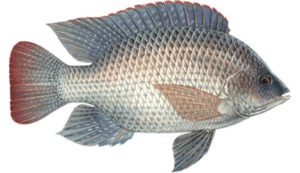Executive Summary
The Aquaculture Project in Nigeria provides for the establishment of an annually production of 250-ton aquaculture farm focused on producing quality fish based on the innovative out-door aquaculture system. The project will allow all year around fresh produce to the market, and later expansion can be made based on market demand.
The farm is to be the premier low-cost and high-quality innovative fish production enterprise for this Nigeria’s market. At full capacity, the farm is projected to sell 250 tons of tilapia and catfish per annum.
The tilapia farm will be integrated into a single company with the common functions of water pumping and supply in land facilities (tanks) using, mainly, water from the closest river or dam, which will be pumped to the tanks.; brood stock and hatchery for producing eggs and nursery for fingerlings, grow out, fish feed store unit processing plant and other resources; management and marketing.
The project will have a variety of fish products such as whole fish, whole fish gutted and scaled, fillet fresh and frozen.
In order to give more flexibility and expansions alternatives for the project we offering also other attractive fish options which suitable for the region.
The chosen fish: Tilapia
 Tilapia is a tropical fish, originating from the sea of Galilee cold St. Peter’s fish. Later on spread through Africa. The family is very large and is divided into many deferent genetics strains. The number of strains which have good growth rate and reproductive qualities allow them to be raised in high density are very limited. The most commonly grown species in aquaculture around the world include Oreochromis niloticus, O. aureus, O. mossambicus, and Tilapia rendali. There are also a number of red tilapia strains, most of which are not pure strains. In order to obtain good growth characteristics, hybridization is necessary.
Tilapia is a tropical fish, originating from the sea of Galilee cold St. Peter’s fish. Later on spread through Africa. The family is very large and is divided into many deferent genetics strains. The number of strains which have good growth rate and reproductive qualities allow them to be raised in high density are very limited. The most commonly grown species in aquaculture around the world include Oreochromis niloticus, O. aureus, O. mossambicus, and Tilapia rendali. There are also a number of red tilapia strains, most of which are not pure strains. In order to obtain good growth characteristics, hybridization is necessary.
Tilapia has an excellent taste and qualitative flash. Therefore, demand for tilapia world-wide is increasing, even amongst populations which did not consume tilapia in the past.
Tilapia is appropriate for aquaculture because of several characteristics, which, as soon as one knows how to take advantage of them, allow tilapia to grow well throughout the year and produce economic benefits:
- It reproduces throughout the year as long as the water temperature is above 24ºC. Every 30 days, the female enters a reproductive cycle.
- If water quality is good, tilapia can be raised in very high density without affecting the growth rate.
- Good feed conversion ratio (FCR), i.e., the weight of the feed required to produce a given weight of fish is no higher than that of other fish. The tilapia’s stomach and digestive system are well-developed.
- It can utilize vegetable proteins as part of its protein requirement. Vegetable protein sources are less expensive than animal sources. Generally, protein is the most expensive ingredient in fish feeds.
- It tolerates poor water quality and low oxygen levels
- Its body shape allows for easy industrial processing. It has few bones.
- The male grows more quickly than the female. There for the production Most farms grow 100% male populations and such populations are produced by hormonal sex reversal.
The chosen fish: Catfish
Catfish (or catfishes; order Siluriformes or Nematognathi) are a diverse group of ray-finned fish. Named for their prominent barbels, which resemble a cat’s whiskers, catfish range in size and behavior from the three largest species, the Mekong giant catfish from Southeast Asia, the wels catfish of Eurasia and the Piraíba of South America, to detritivores (species that eat dead material on the bottom), and even to a tiny parasitic species commonly called the candiru, Vandellia cirrhosa. There are armour-plated types and there are also naked types, neither having scales.
the Mekong giant catfish from Southeast Asia, the wels catfish of Eurasia and the Piraíba of South America, to detritivores (species that eat dead material on the bottom), and even to a tiny parasitic species commonly called the candiru, Vandellia cirrhosa. There are armour-plated types and there are also naked types, neither having scales.
Despite their name, not all catfish have prominent barbel. Catfish are of considerable commercial importance; many of the larger species are farmed or fished for food.
Catfish are most diverse in tropical South America, Asia and Africa with one family native to North America and one family in Europe. More than half of all catfish species live in the Americas. They are the only ostariophysans that have entered freshwater habitats in Madagascar, Australia, and New Guinea. Catfish are easy to farm in warm climates, leading to inexpensive and safe food at local grocers. About 60% of U.S. farm-raised catfish are grown within a 65-mile (100-km) radius of Belzoni, Mississippi. Channel catfish (Ictalurus punctatus) supports a $450 million/yr aquaculture industry.
Catfish raised in inland tanks or channels are considered safe for the environment, since their waste and disease should be contained and not spread to the wild.
TheBudget
The estimated budget for 250MT annual production project is 4,855,000 USD